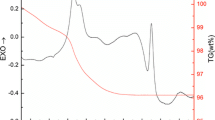The influence of temperature-time parameters on linear thermal expansion coefficient (LTEC) of materials based upon MoSi2-B-Al2O3 is established. It is shown that by changing composite composition and heat treatment conditions it is possible to influence the LTEC value significantly.



Similar content being viewed by others
References
A. G. Shchurik, Artificial Carbon Materials [in Russian], Izd. Perm. Gos. Univ., Perm’ (2009).
Y. R. Niu, Z. Wang, J. Zhao, et al., “Comparison of ZrB2-MoSi2 composite coatings fabricated by atmospheric and vacuum plasma spray processes,” J. Therm. Spray Technol., No. 26, 100 – 107 (2017).
Y. L. Zhang, H. J. Li, X. Y. Yao, et al., “C/SiC/Si–Mo–B/glass multilayer oxidation protective coating for carbon/carbon composites,” Surf. Coat. Technol., No. 206, 492 – 496 (2011).
T. Feng, H. J. Li, Q. G. Fu, et al., “ Microstructure and oxidation of multilayer MoSi2-CrSi2-Si coatings for SiC coated carbon/carbon composites SiC internal layer,” Corros. Sci., No. 52, 3011 – 3017 (2010).
T. Li, H. J. Li, and X. H. Shi, “Effect of LaB6 on the thermal shock property of MoSi2–SiC coating for carbon/carbon composites,” Appl. Surf. Sci., No. 264, 88 – 93 (2013).
M. V. Sazonova, I. B. Ban’kovskaya, and D. V. Kolovertnov, “Thermal stability of composites and coatings based on MoSi2–B–Al2O3 when heated in air to 1600°C, ”Refract. Ind. Ceram., 62(6), 668 – 671 (2022).
D. V. Kolovertnov, I. B. Ban’kovskaya, M. V. Sazonova, “Effect of temperature – time parameters on the structure and properties of glass-ceramic composites based on molybdenum disilicide,” Glass Phys. Chem., 48(6), 642 – 645 (2022).
V/P/Klyuev and B. Z. Pevzner, “Thermal expansion and vitrification temperature of calcium-borate and calcium aluminoborate glasses,” Fiz.-Khim. Stekla, 29(2), 191 – 204 (2003).
H. Wu, H. J. Li, Q. Lei, et al., “Effect of spraying power on microstructure and bonding strength of MoSi2-based coatings prepared by supersonic plasma spraying,” Appl. Surf. Sci., No. 257, 5566 – 5570 (2011).
C. C.Wang, K. Z. Li, C. X. Huo, et al., “Oxidation behavior and microstructural evolution of plasma sprayed La2O3-MoSi2-SiC coating on carbon/carbon composites,” Surf. Coat. Technol. No. 348, 81 – 90 (2018).
Peng Chen, Lu Zhu, Xuanru Ren, et al., “Preparation of oxidation protective MoSi2-SiC coating on graphite using recycled waste MoSi2 by one-step spark plasma sintering method,” Ceram. Int., No. 45, 22040 – 22046 (2019).
A. N. Nikolaev, I. B. Ban’kovskaya, and D. V. Kolovertnov, “Synthesis and study of the properties of heat-resistant coatings based upon composite Si–B4C–ZrB2–ZrO2,” Fiz. Khim. Stekla, 46(6), 649 – 657 (2020).
Laura Silvestroni, Simone Failla, Irina Neshpo, and Oleg Grigoriev, “Method to improve the oxidation resistance of ZrB2-based ceramics for reusable space systems,” J. Eur. Ceram. Soc., No. 38, 2467 – 2476 (2018).
H. Zhang, D. D. Jayaseelan, I. Bogomol, et al., “A novel microstructural design to improve the oxidation resistance of ZrB2-SiC ultrahigh temperature ceramics (UHTCs),” J. Alloys Compounds, No. 785, 958 – 964 (2019).
I. B. Ban’kovskaya, and M. V. Sazonova, “Thermal stability of composite of molybdenum disilicide, quartz, and glass. Anticorrosion coatings,” Proc. All-Union Meeting on Heat-Resistant coatings,, Leningrad 12 – 14 May 1981, Nauka, Leningrad (1983).
I. B. Ban’kovskaya, and D. V. Kolovertnov, “Development of work for creating protective coatings for carbon materials at high temperatures (review of IKhS RAN work),” Fiz. Khim. Stekla, 43(2), 156 – 171 (2017).
V. V. Malyshev, R. V. Kuprina, I. A. Novoselova, and T. V. Verkhovlyuk, “Gigh-temperature electrochemical synthesis of group VI-A metal within halogen-oxide melts,” Zh. Neorg. Khim., 41(12), 1992 – 1996 (1966).
I. B. Ban’kovskaya, and M. V. Sazonova, “Thermal stability of some glass-ceramic composites at 1400°C,” Heat-Resistant Coatings: proc. 11th All-Union Meeting on Heat-Resistant coatings, 31 May – 2 June 1983, Leningrad, Nauka (1985).
Author information
Authors and Affiliations
Corresponding author
Additional information
Translated from Novye Ogneupory, No. 7, pp. 38 – 41, July, 2023.
Rights and permissions
Springer Nature or its licensor (e.g. a society or other partner) holds exclusive rights to this article under a publishing agreement with the author(s) or other rightsholder(s); author self-archiving of the accepted manuscript version of this article is solely governed by the terms of such publishing agreement and applicable law.
About this article
Cite this article
Ban’kovskaya, I.B., Kolovertnov, D.V. & Sazonova, M.V. Linear Expansion Temperature Coefficient of Glass Ceramic Materials Based on MoSi2. Refract Ind Ceram 64, 393–396 (2023). https://doi.org/10.1007/s11148-024-00859-9
Received:
Published:
Issue Date:
DOI: https://doi.org/10.1007/s11148-024-00859-9




